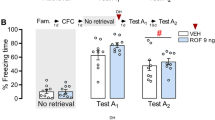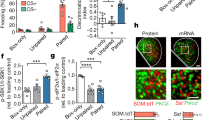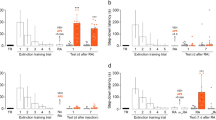Abstract
Repeated presentations of a previously conditioned stimulus lead to a new form of learning known as extinction, which temporarily alters the response to the original stimulus. Previous studies have shown that the consolidation of extinction memory requires de novo protein synthesis. However, the role of specific nodes of translational control in extinction is unknown. Using auditory threat conditioning in mice, we investigated the role of mechanistic target of rapamycin complex 1 (mTORC1) and its effector p70 S6 kinase 1 (S6K1) in the extinction of auditory threat conditioning. We found that rapamycin attenuated the consolidation of extinction memory. In contrast, genetic deletion and pharmacological inhibition of S6K1, a downstream effector of mTORC1, blocked within-session extinction, indicating a role for S6K1 independent of protein synthesis. Indeed, the activation of S6K1 during extinction required extracellular signal-regulated kinase (ERK) activation in the basolateral nucleus of the amygdala (BLA) and was necessary for increased phosphorylation of the GluA1 (Thr840) subunit of the AMPA receptor following extinction training. Mice exposed to brief uncontrollable stress showed impaired within-session extinction as well as a downregulation of ERK and S6K1 signaling in the amygdala. Finally, using fiber photometry we were able to record calcium signals in vivo, and we found that inhibition of S6K1 reduces extinction-induced changes in neuronal activity of the BLA. These results implicate a novel ERK-S6K1-GluA1 signaling cascade critically involved in extinction.
This is a preview of subscription content, access via your institution
Access options
Subscribe to this journal
Receive 12 print issues and online access
$259.00 per year
only $21.58 per issue
Buy this article
- Purchase on Springer Link
- Instant access to full article PDF
Prices may be subject to local taxes which are calculated during checkout




Similar content being viewed by others
References
Sotres-Bayon F, Quirk GJ . Prefrontal control of fear: more than just extinction. Curr Opin Neurobiol 2010; 20: 231–235.
Quirk GJ, Mueller D . Neural mechanisms of extinction learning and retrieval. Neuropsychopharmacology 2007; 33: 56–72.
Myers KM, Davis M . Mechanisms of fear extinction. Mol Psychiatry 2006; 12: 120–150.
Herry C, Trifilieff P, Micheau J, Lüthi A, Mons N . Extinction of auditory fear conditioning requires MAPK/ERK activation in the basolateral amygdala. Eur J Neurosci 2006; 24: 261–269.
Sotres-Bayon F, Bush DEA, LeDoux JE . Acquisition of fear extinction requires activation of NR2B-containing NMDA receptors in the lateral amygdala. Neuropsychopharmacology 2007; 32: 1929–1940.
Hugues S . Postextinction infusion of a mitogen-activated protein kinase inhibitor into the medial prefrontal cortex impairs memory of the extinction of conditioned fear. Learn Mem 2004; 11: 540–543.
Sotres-Bayon F, Diaz-Mataix L, Bush DEA, Ledoux JE . Dissociable roles for the ventromedial prefrontal cortex and amygdala in fear extinction: NR2B contribution. Cereb Cortex 2009; 19: 474–482.
Santini E . Consolidation of fear extinction requires protein synthesis in the medial prefrontal cortex. J Neurosci 2004; 24: 5704–5710.
Santini E, Huynh TN, Klann E . Mechanisms of translation control underlying long-lasting synaptic plasticity and the consolidation of long-term memory. Prog Mol Biol Transl Sci 2014; 122: 131–167.
Huynh TN, Santini E, Klann E . Requirement of mammalian target of rapamycin complex 1 downstream effectors in cued fear memory reconsolidation and its persistence. J Neurosci 2014; 34: 9034–9039.
Hoeffer CA, Cowansage KK, Arnold EC, Banko JL, Moerke NJ, Rodriguez R et al. Inhibition of the interactions between eukaryotic initiation factors 4E and 4G impairs long-term associative memory consolidation but not reconsolidation. Proc Natl Acad Sci 2011; 108: 3383–3388.
Iijima Y . c-Raf/MEK/ERK pathway controls protein kinase C-mediated p70S6K activation in adult cardiac muscle cells. J Biol Chem 2002; 277: 23065–23075.
Izquierdo A . Brief uncontrollable stress causes dendritic retraction in infralimbic cortex and resistance to fear extinction in mice. J Neurosci 2006; 26: 5733–5738.
Hoffman AN, Lorson NG, Sanabria F, Foster Olive M, Conrad CD . Chronic stress disrupts fear extinction and enhances amygdala and hippocampal Fos expression in an animal model of post-traumatic stress disorder. Neurobiol Learn Mem 2014; 112: 139–147.
Shima H, Pende M, Chen Y, Fumagalli S, Thomas G, Kozma SC . Disruption of the p70(s6k)/p85(s6k) gene reveals a small mouse phenotype and a new functional S6 kinase. EMBO J 1998; 17: 6649–6659.
Santini E, Huynh TN, MacAskill AF, Carter AG, Pierre P, Ruggero D et al. Exaggerated translation causes synaptic and behavioural aberrations associated with autism. Nature 2013; 493: 411–415.
Gunaydin LA, Grosenick L, Finkelstein JC, Kauvar IV, Fenno LE, Adhikari A et al. Natural neural projection dynamics underlying social behavior. Cell 2014; 157: 1535–1551.
Antion MD, Merhav M, Hoeffer CA, Reis G, Kozma SC, Thomas G et al. Removal of S6K1 and S6K2 leads to divergent alterations in learning, memory, and synaptic plasticity. Learn Mem 2008; 15: 29–38.
Delgado JY, Coba M, Anderson CNG, Thompson KR, Gray EE, Heusner CL et al. NMDA receptor activation dephosphorylates AMPA receptor glutamate receptor 1 subunits at threonine 840. J Neurosci 2007; 27: 13210–13221.
Aubry AV, Serrano PA, Burghardt NS . Molecular mechanisms of stress-induced increases in fear memory consolidation within the amygdala. Front Behav Neurosci 2016; 10: 191.
Chen T-W, Wardill TJ, Sun Y, Pulver SR, Renninger SL, Baohan A et al. Ultrasensitive fluorescent proteins for imaging neuronal activity. Nature 2013; 499: 295–300.
Lee HK, Barbarosie M, Kameyama K, Bear MF, Huganir RL . Regulation of distinct AMPA receptor phosphorylation sites during bidirectional synaptic plasticity. Nature 2000; 405: 955–959.
Jenkins MA, Wells G, Bachman J, Snyder JP, Jenkins A, Huganir RL et al. Regulation of GluA1 α-amino-3-hydroxy-5-methyl-4-isoxazolepropionic acid receptor function by protein kinase C at serine-818 and threonine-840. Mol Pharmacol 2014; 85: 618–629.
Quirk GJ, Armony JL, LeDoux JE . Fear conditioning enhances different temporal components of tone-evoked spike trains in auditory cortex and lateral amygdala. Neuron 1997; 19: 613–624.
Herry C, Ciocchi S, Demmou L, Muller C, Luthi A . Switching on and off fear by distinct neuronal circuits. Nature 2008; 454: 600–606.
Campbell DG, Felker BL, Liu C-F, Yano EM, Kirchner JE, Chan D, Rubinstein LV, Chaney EF . Prevalence of depression-PTSD comorbidity: implications for clinical practice guidelines and primary care-based interventions. J Gen Intern Med 2007; 22: 711–718.
Jernigan CS, Goswami DB, Austin MC, Iyo AH, Chandran A, Stockmeier CA et al. The mTOR signaling pathway in the prefrontal cortex is compromised in major depressive disorder. Prog Neuropsychopharmacol Biol Psychiatry 2011; 35: 1774–1779.
Dwyer JM, Maldonado-Avilés JG, Lepack AE, DiLeone RJ, Duman RS . Ribosomal protein S6 kinase 1 signaling in prefrontal cortex controls depressive behavior. Proc Natl Acad Sci 2015; 112: 6188–6193.
Bhattacharya A, Kaphzan H, Alvarez-Dieppa AC, Murphy JP, Pierre P, Klann E . Genetic removal of p70 S6 kinase 1 corrects molecular, synaptic, and behavioral phenotypes in fragile X syndrome mice. Neuron 2012; 76: 325–337.
Santini E, Klann E . Reciprocal signaling between translational control pathways and synaptic proteins in autism spectrum disorders. Sci Signal 2014; 7: re10–re10.
Acknowledgements
We thank Chris Cain and the LeDoux lab for their input throughout the development of this project, Francis S Lee for his advice regarding the manuscript text and Shawn Singh for his assistance with Nissl staining. This work was funded by grants from the National Institutes of Health grants to EK (NS034007, NS047384 and HD082013) and ES (NS087112).
Author contributions
TNH, CL, JEL and EK designed the research. TNH, ES, EM, AEF, BSH and RNF performed the experiments. LG, KD and CL contributed to the development of the fiber photometry experiments. TNH and EK analyzed the data and wrote the manuscript, which was edited by all authors.
Author information
Authors and Affiliations
Corresponding author
Ethics declarations
Competing interests
The authors declare no conflict of interest.
Additional information
Supplementary Information accompanies the paper on the Molecular Psychiatry website
Supplementary information
Rights and permissions
About this article
Cite this article
Huynh, T., Santini, E., Mojica, E. et al. Activation of a novel p70 S6 kinase 1-dependent intracellular cascade in the basolateral nucleus of the amygdala is required for the acquisition of extinction memory. Mol Psychiatry 23, 1394–1401 (2018). https://doi.org/10.1038/mp.2017.99
Received:
Revised:
Accepted:
Published:
Issue Date:
DOI: https://doi.org/10.1038/mp.2017.99
This article is cited by
-
p85S6K sustains synaptic GluA1 to ameliorate cognitive deficits in Alzheimer’s disease
Translational Neurodegeneration (2023)
-
N-acetylcysteine facilitates extinction of cued fear memory in rats via reestablishing basolateral amygdala glutathione homeostasis
Acta Pharmacologica Sinica (2022)
-
The mTORC1 inhibitor rapamycin and the mTORC1/2 inhibitor AZD2014 impair the consolidation and persistence of contextual fear memory
Psychopharmacology (2020)



